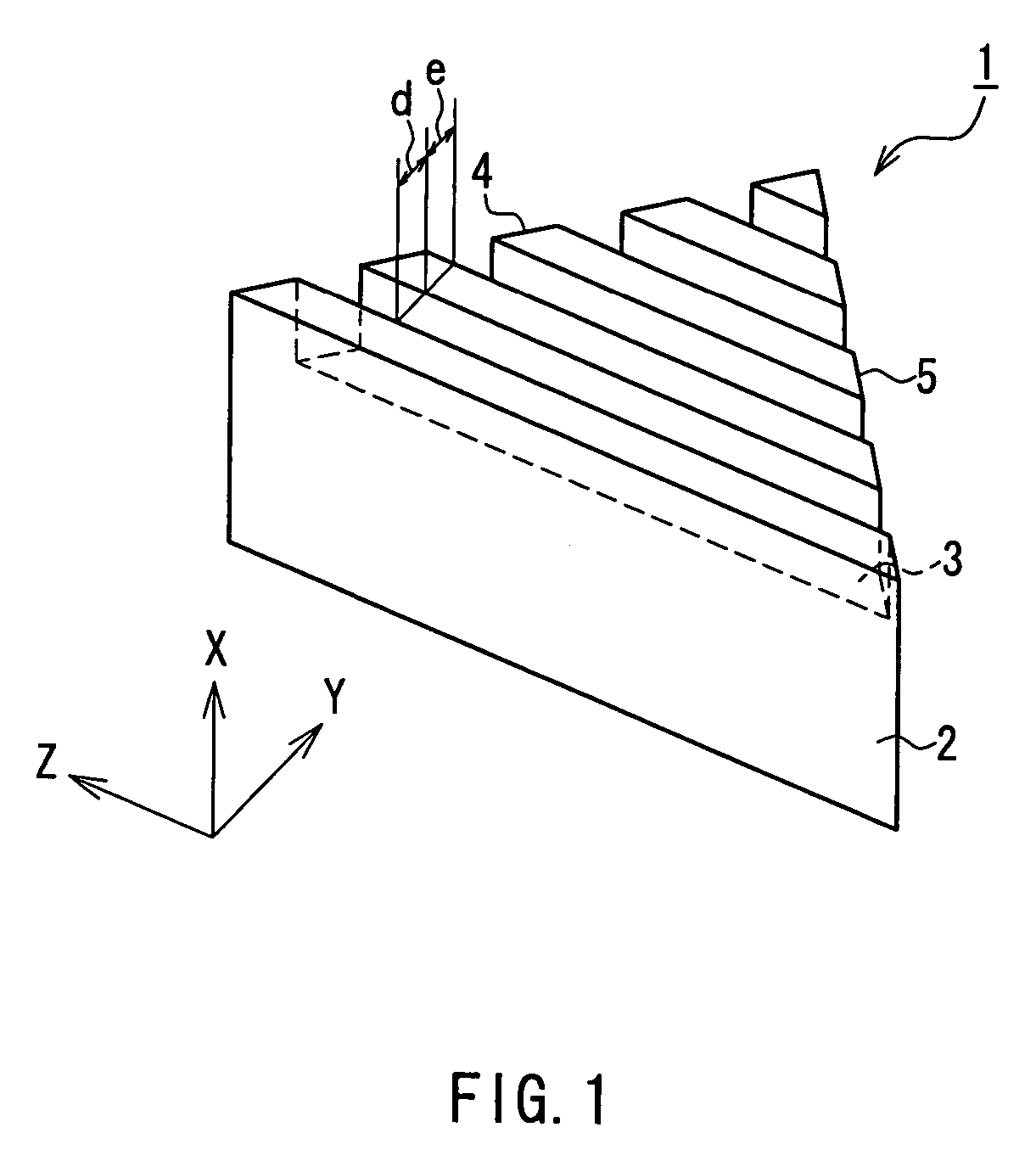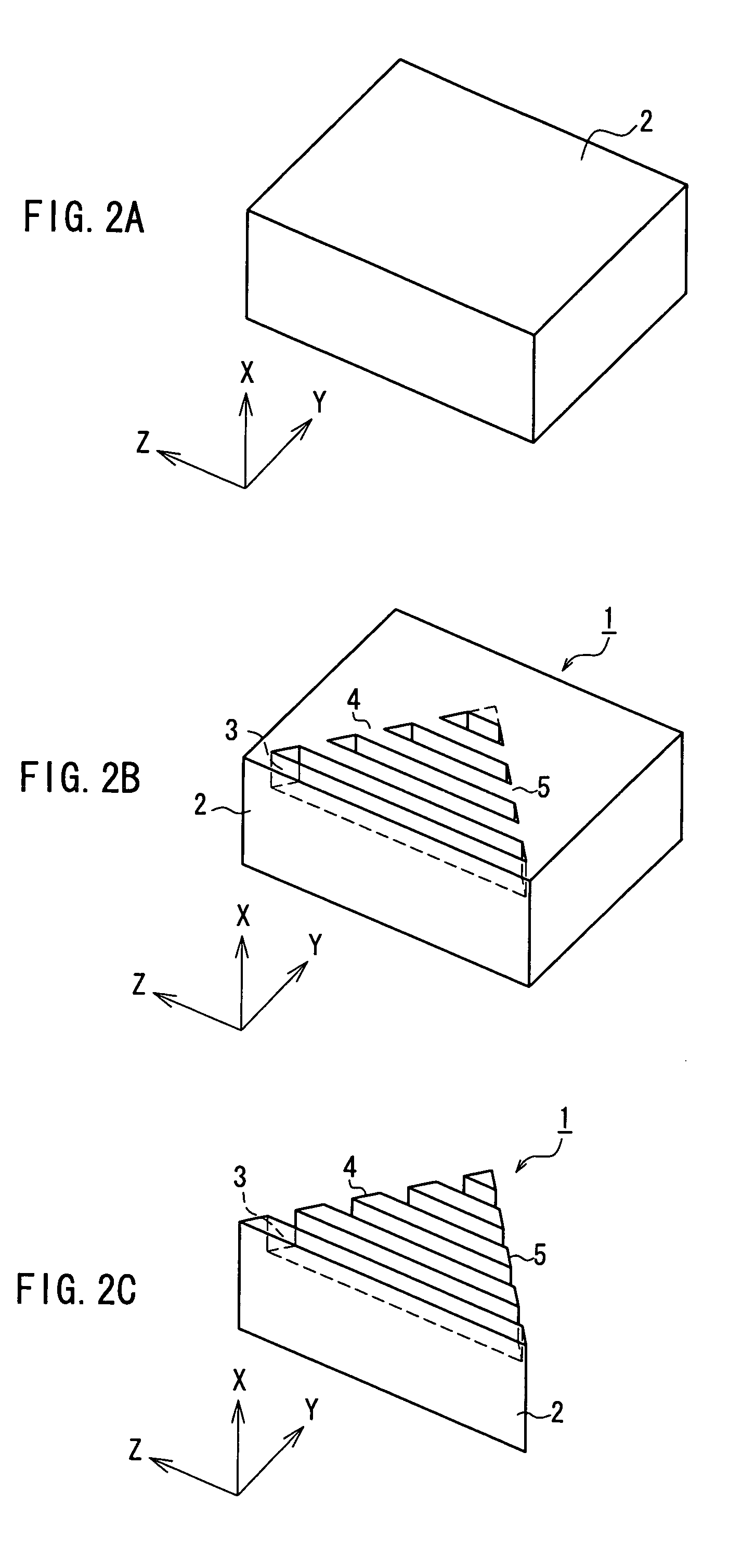Optical element and wavelength separator using the same
a wavelength separator and optical element technology, applied in the field of optical elements, can solve the problems of difficult production of two- or three-dimensional photonic structures, and achieve the effects of high wavelength resolution, small size, and easy manufacturing
- Summary
- Abstract
- Description
- Claims
- Application Information
AI Technical Summary
Benefits of technology
Problems solved by technology
Method used
Image
Examples
embodiment 1
[0068]The following describes an optical element according to Embodiment 1 of the present invention. FIG. 1 is a perspective view illustrating a configuration of an optical element according to Embodiment 1 of the present invention. In FIG. 1, the optical element 1 is configured by forming grooves 3 in a homogeneous medium 2. The grooves 3 are formed in parallel so as to extend in one direction and have uniform widths. Intervals at which the grooves 3 are arranged also are uniform. It should be noted that, as shown in FIG. 1, the direction in which the grooves 3 extend is a Z-axis direction, a direction in which layers of the homogeneous medium 2 and air filling the grooves 3 are stacked is a Y-axis direction, and a direction perpendicular to both the Z axis and the Y axis is an X-axis direction. In other words, the grooves 3 are parallel with an X-Z plane, and are stacked in the Y-axis direction. Thus, the optical element 1 is configured so that air and the homogeneous medium 2 are...
example 1
[0096]The following describes Example 1 in which the propagation in the optical element 1a (see FIG. 3) according to Embodiment 1 was determined by simulation. The optical element 1a was a periodic structure in which a substance having a refractive index of 1.45 and a substance having a refractive index of 1.00 were provided alternately with uniform thicknesses. The structure had an incident end face 4 inclined through an angle ψ1 of 45° and a period a of 1000 (nm). The simulation was performed with an incident angle θ of an incident light beam 7 being fixed to 15°, and with a wavelength λ0 of the incident light beam 7 being varied from a / 0.460 to a / 0.485.
Resultant output angles φ of outgoing light beams corresponding to the foregoing respective wavelengths are shown in Table 1. It should be noted that the output angle φ is an angle formed between the Z-axis direction and the outgoing light beam.
[0097]
TABLE 1No.a / λ0Wave length λ0Output angle φ (deg)10.4602173.9143.520.4652150.5437.5...
example 2
[0100]The following describes Example 2 in which the propagation in the optical element 1a according to Embodiment 1 was determined by simulation. The optical element 1a was a periodic structure in which a substance having a refractive index of 1.45 and a substance having a refractive index of 1.00 were provided alternately with uniform thicknesses. The structure had an incident end face 4 inclined through an angle ψ1 of 50° and a period a of 1000 (nm). The simulation was performed with an incident angle θ of an incident light beam 7 being fixed to 35°, and with a wavelength λ0 of the incident light beam7 being varied from a / 0.420 to a / 0.450. Resultant output angles φ of outgoing light beams corresponding to the foregoing respective wavelengths are shown in Table 2.
[0101]
TABLE 2No.a / λ0Wave length λ0Output angle φ (deg)10.4202380.9537.520.4252352.9431.530.4302325.5827.540.4352298.8524.350.4402272.7321.260.4452247.1918.570.4502222.2214.0
[0102]As shown in Table 2, a change in the outpu...
PUM
 Login to View More
Login to View More Abstract
Description
Claims
Application Information
 Login to View More
Login to View More - R&D
- Intellectual Property
- Life Sciences
- Materials
- Tech Scout
- Unparalleled Data Quality
- Higher Quality Content
- 60% Fewer Hallucinations
Browse by: Latest US Patents, China's latest patents, Technical Efficacy Thesaurus, Application Domain, Technology Topic, Popular Technical Reports.
© 2025 PatSnap. All rights reserved.Legal|Privacy policy|Modern Slavery Act Transparency Statement|Sitemap|About US| Contact US: help@patsnap.com



